Sir John Monash, Personal Files Book 13, 1 July - 16 August 1916, Part 15
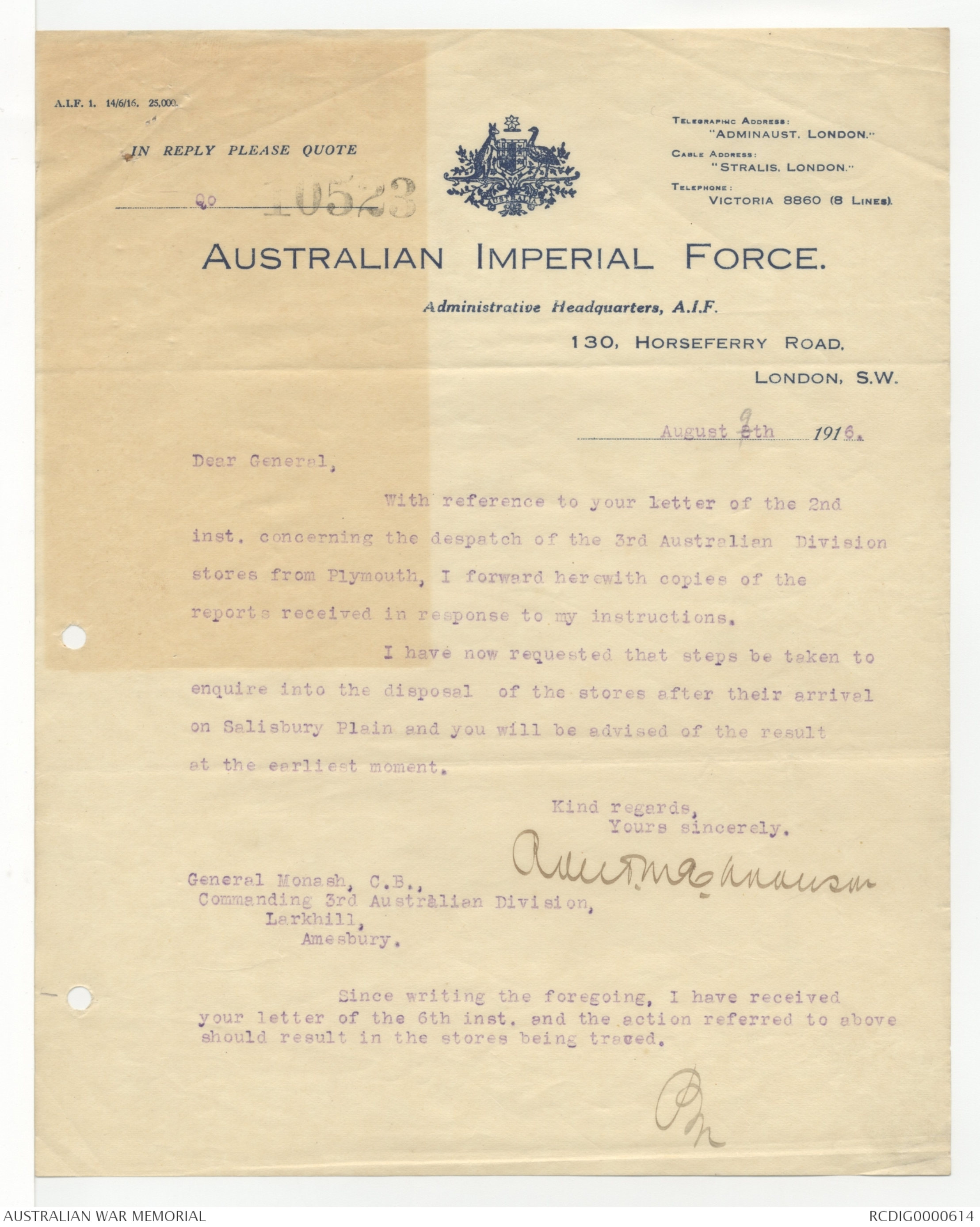
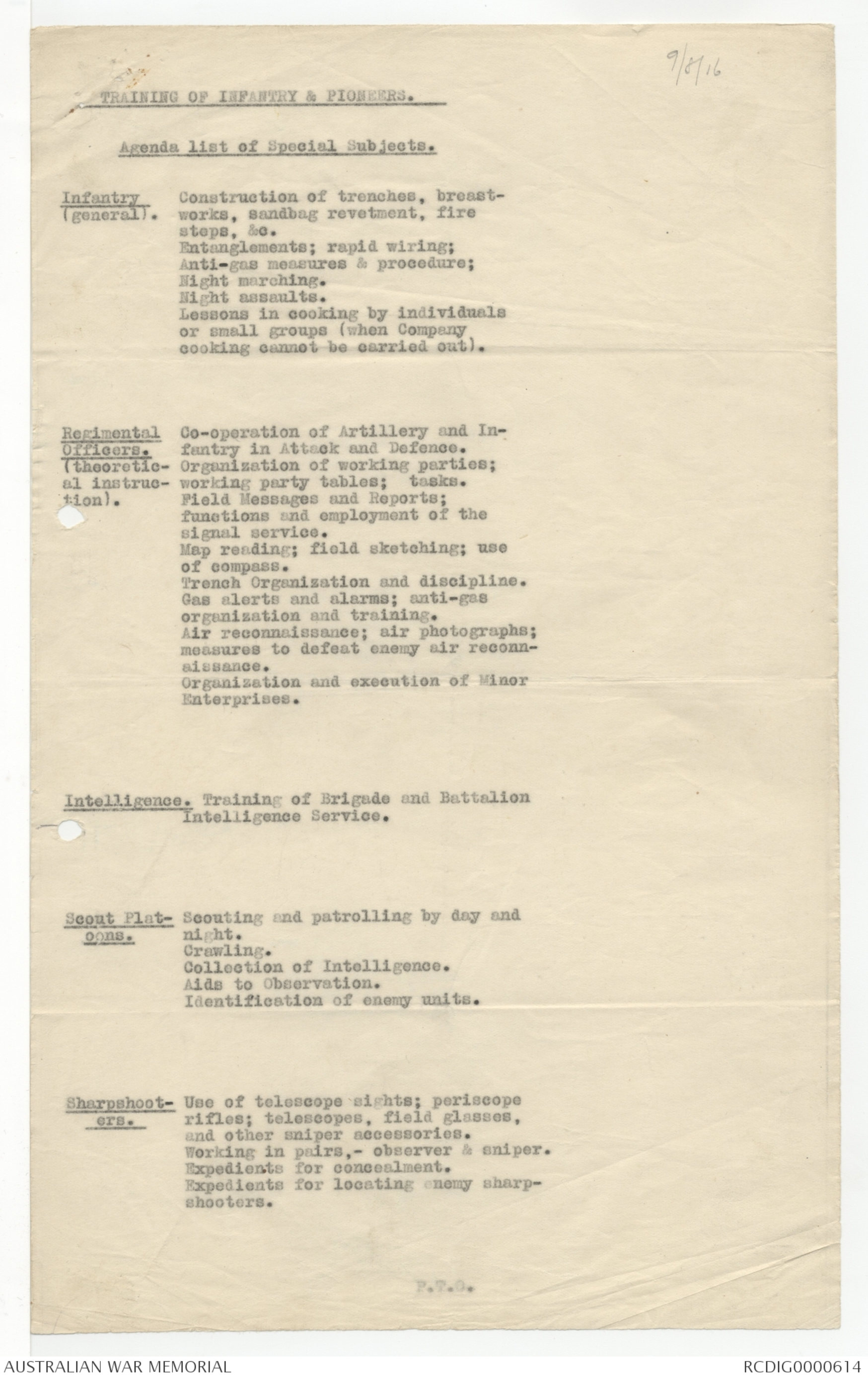
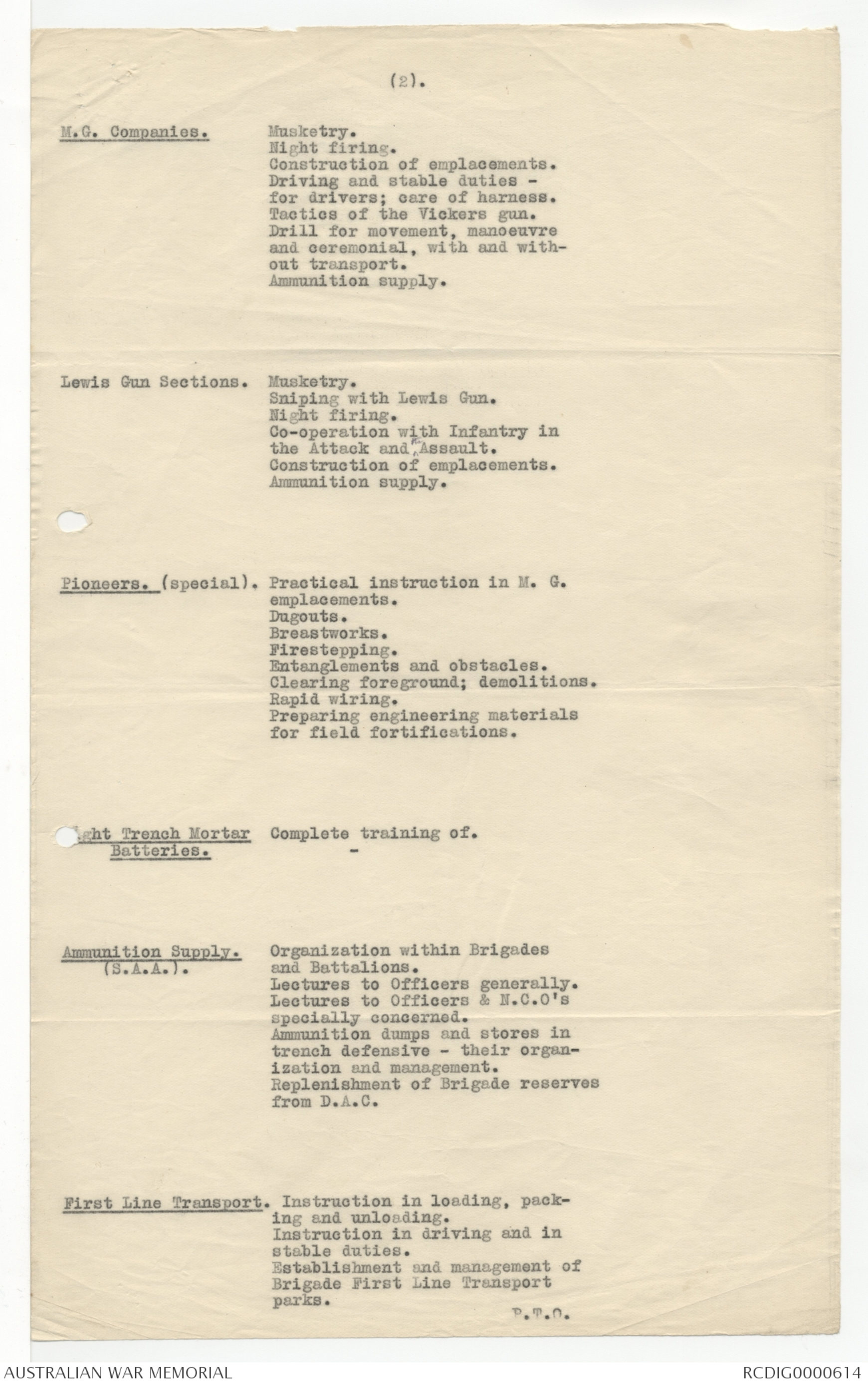
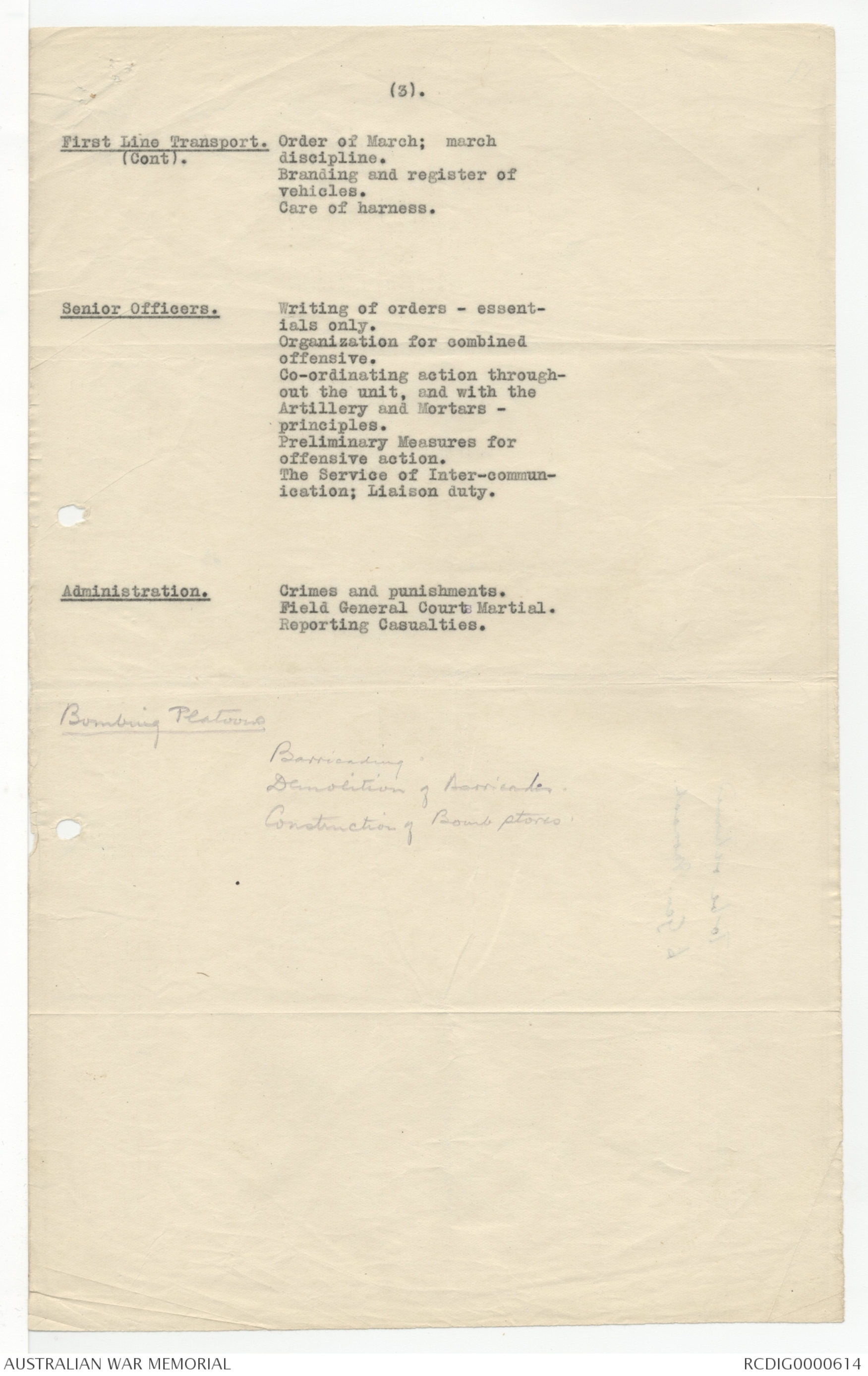
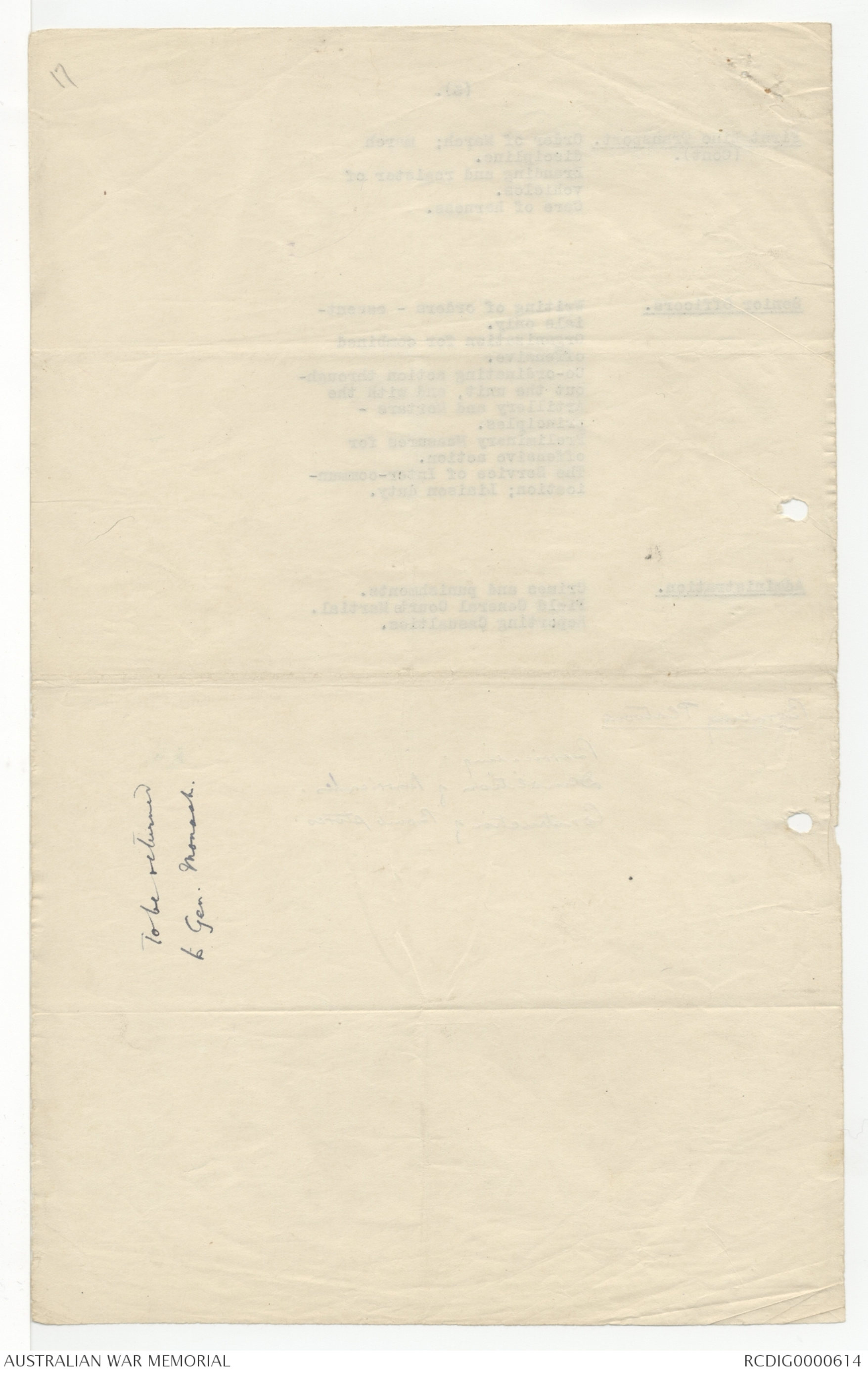
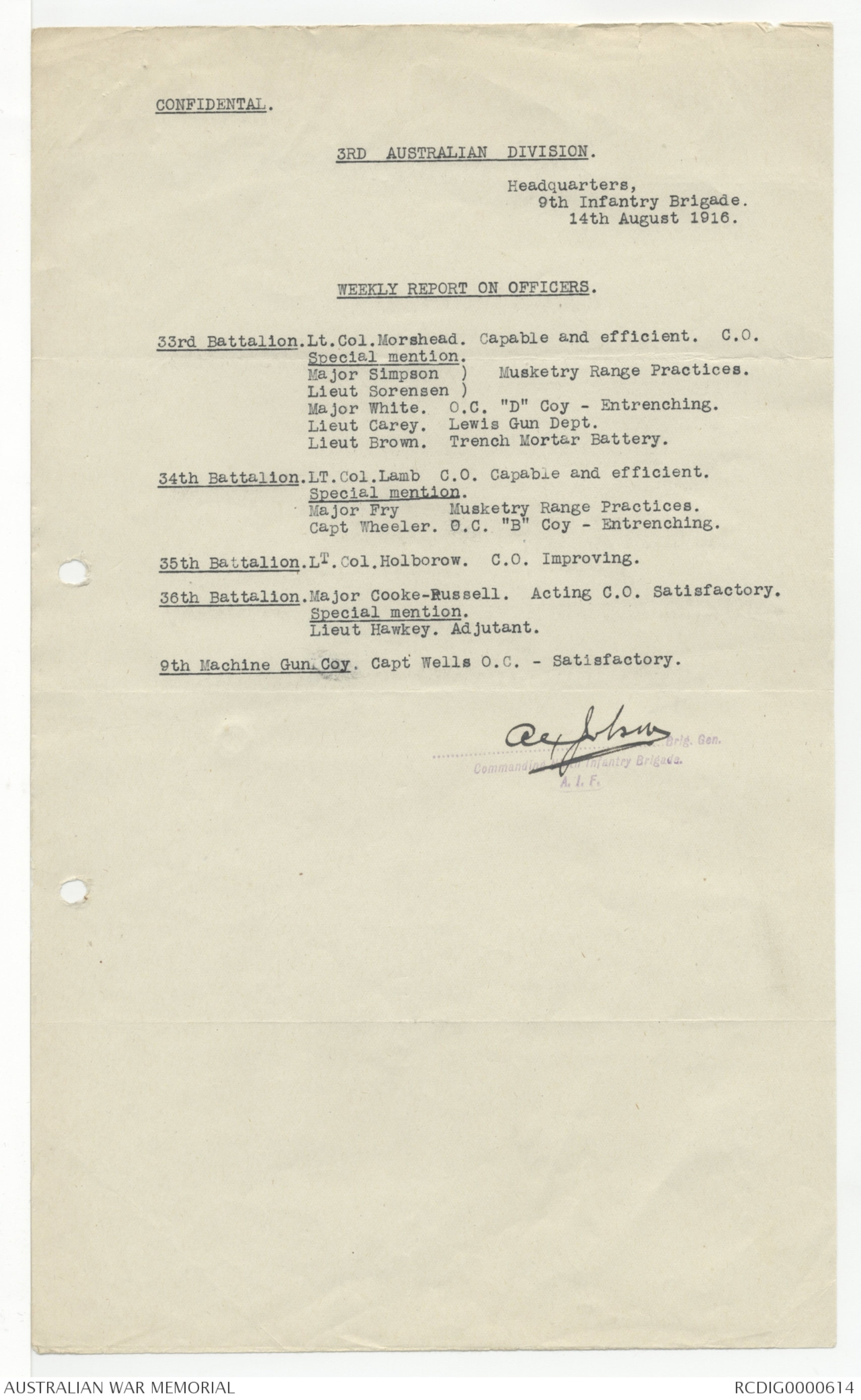
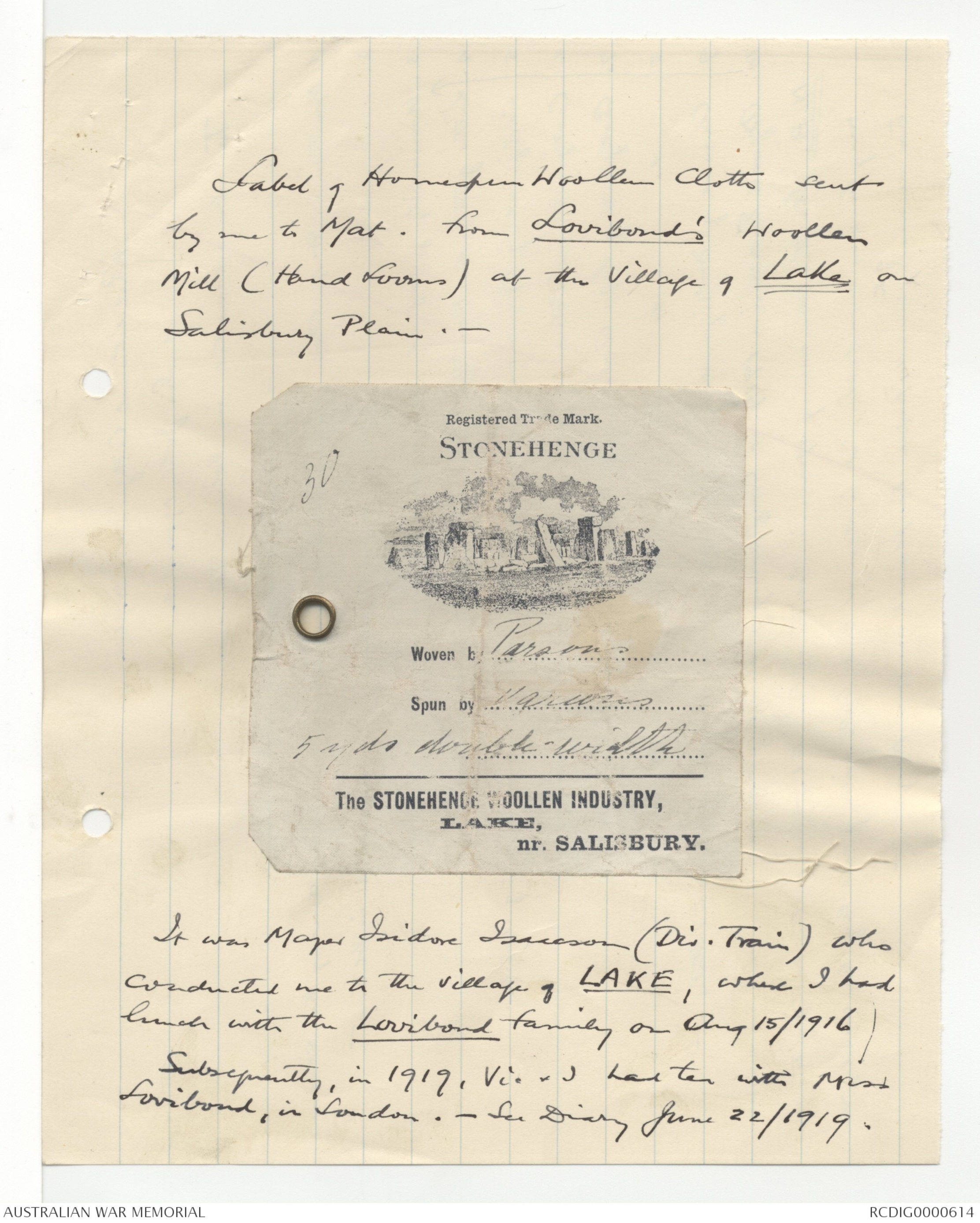
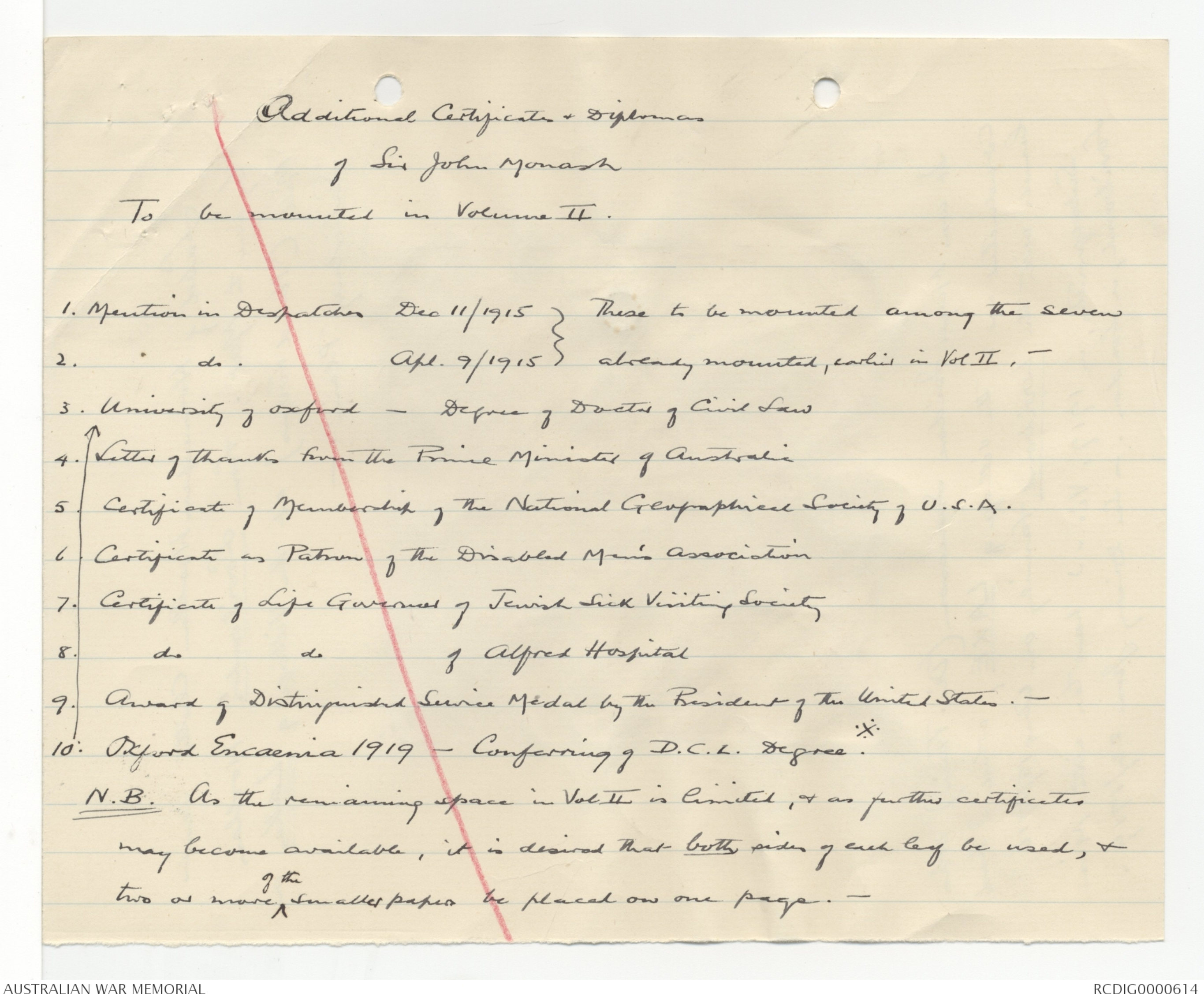
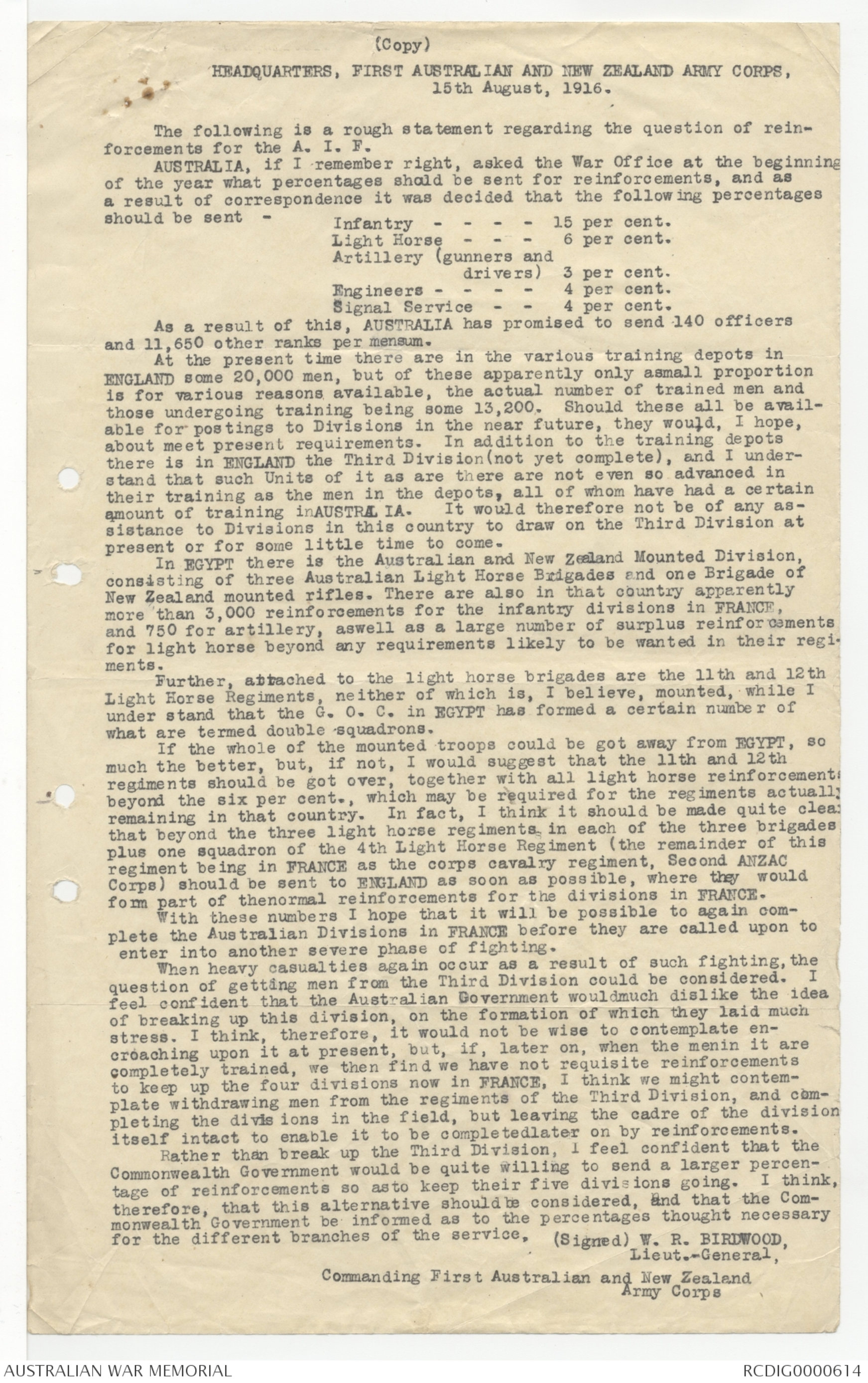
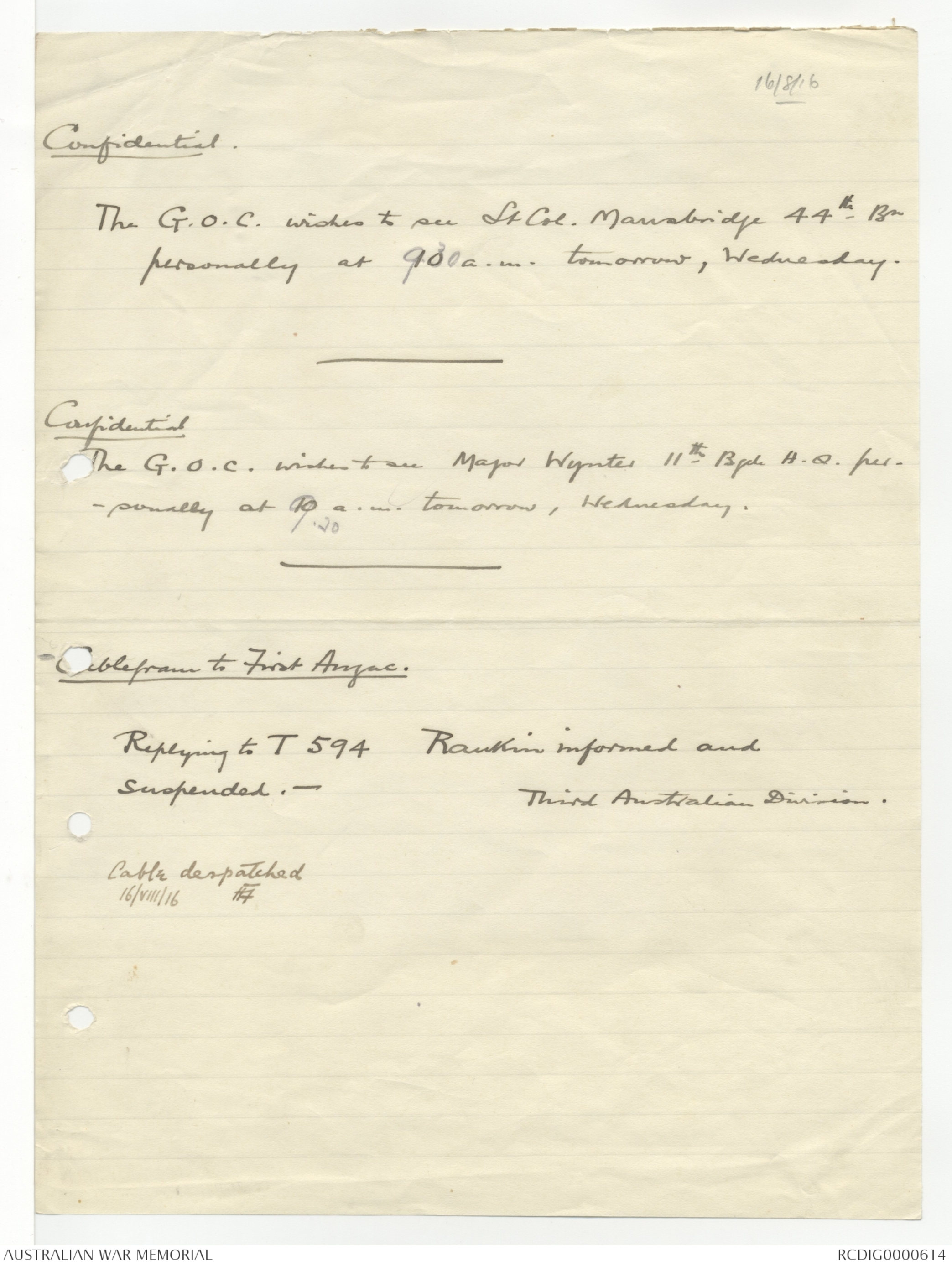
A.L.F.1. 14/6/16. 25000
IN REPLY PLEASE QUOTE
QO 10523
TELEGRAPHIC ADDRESS:
"ADMINAUST. LONDON"
CABLE ADDRESS:
"STRALIS, LONDON"
TELEPHONE:
VICTORIA 8860 (8 LINES)
AUSTRALIAN IMPERIAL FORCE
Administrative Headquarters, A.I.F.
130, HORSEFERRY ROAD,
LONDON, SW.
August 8 9th 1916.
Dear General,
With reference to your letter of the 2nd
inst. concerning the despatch of the 3rd Australian Division
stores from Plymouth I forward herewith copies of the
reports received in response to my instructions.
I have now requested that steps be taken to
enquire into the disposal of the stores after their arrival
on Salisbury Plain and you will be advised of the result
at the earliest moment.
Kind regards
Yours sincerely.
[[AWT McMason?]]
General Monash, C.B
Commanding 3rd Australian Division,
Larkhill
Amesbury.
Since writing the foregoing, I have received
your letter of the 6th inst, and the action referred to above
should result in the stores being traced.
AM
TRAINING OF INFANTRY & PIONEERS.
Agenda list of Special Subjects.
Infantry
(general).
Construction of trenches, breastworks,
sandbag revetment, fire
steps, &c.
Entanglements; rapid wiring;
Anti-gas measures & procedure;
Night marching.
Night assaults.
Lessons in cooking by individuals
or small groups (when Company
cooking cannot be carried out).
Regimental
Officers.
Co-operation of Artillery and Infantry
in Attack and Defence.
Organization of working parties;
working party tables; tasks.
Field Messages and Reports
functions and employment of the
signal service.
Map reading; field sketching; use
of compass.
Trench Organization and discipline.
Gas alerts and alarms; anti-gas
organization and training.
Air reconnaissance; air photographs;
measures to defeat enemy air
reconnaissance.
Organization and execution of Miner
Enterprises.
Intelligence.
Training of Brigade and Battalion
Intelligence Service.
Scout Platoons
Scouting and patrolling by day and
night.
Crawling.
Collection of Intelligence.
Aids to Observation.
Identification of enemy units.
Sharpshooters.
Use of telescope sights; periscope
rifles; telescopes, field glasses,
and other sniper accessories.
Working in pairs,- observer & sniper.
Expedients for concealment.
Expedients for locating enemy sharp-
shooters.
P.T.O.
(2).
M.G. Companies.
Musketry.
Night firing.
Construction of emplacements.
Driving and stable duties -
for drivers; care of harness.
Tactics of the Vickers gun.
Drill for movement, manoeuvre
and ceremonial, with and
without transport.
Ammunition supply.
Lewis Gun Sections.
Musketry.
Sniping with Lewis Gun.
Night firing.
Co-operation with Infantry in
the Attack and, ^ the Assault.
Construction of emplacements.
Ammunition supply.
Pioneers. (special).
Practical instruction in M. G.
emplacements.
Dugouts.
Breastworks.
Firestepping.
Entanglements and obstacles.
Clearing foreground; demolitions.
Rapid wiring.
Preparing engineering materials
for field fortifications.
Light Trench Mortar Batteries.
Complete training of
-
Ammunition Supply.
(S.A.A.).
Organization within Brigades
and Battalions.
Lectures to Officers generally.
Lectures to Officers & N.C.O's
specially concerned.
Ammunition dumps and stores in
trench defensive - their organization
and management.
Replenishment of Brigade reserves
from D.A.C.
First Line Transport.
Instruction in loading, packing
and unloading.
Instruction in driving and in
stable duties.
Establishment and management of
Brigade First Line Transport
parks.
P.T.O
(3).
First Line Transport.
(cont).
Order of March; march
discipline.
Branding and register of
vehicles.
Care of harness.
Senior Officers.
Writing of orders - essentials
only.
Organization for combined
offensive.
Co-ordinating action throughout
the unit, and with the
Artillery and Mortars -
principles.
Preliminary Measures for
offensive action.
The Service of Inter-communication;
Liaison duty.
Administration.
Crimes and punishments.
Field General Courts Martial.
Reporting Casualties.
Bombing Platoons
Barricading
Demolition; barricades
Construction; Bomb stores
17
To be returned
to Gen Monash.
CONFIDENTAL.
3RD AUSTRALIAN DIVISION
Headquarters,
9th Infantry Brigade.
14th August 1916.
WEEKLY REPORT ON OFFICERS.
33rd Battalion. Lt.Col. Morshead. Capable and efficient. C.O.
Special mention.
Major Simpson )Musketry Range Practices.
Lieut Sorensen )
Major White. O.C. "D" Coy - Entrenching.
"Lieut Carey. Lewis Gun Dept.
Lieut Brown. Trench Mortar Battery.
34th Battalion. LT.Col. Lamb C.O. Capable and efficient.
Special mention.
Major Fry Musketry Range Practices.
Capt Wheeler. O.C. "B" Coy - Entrenching.
35th Battalion. LT.Col. Holborow. C.O. Improving.
36th Battalion. Major Cooke-Russell. Acting C.O. Satisfactory.
Special mention.
Lieut Hawkey. Adjutant.
9th Machine Gun Coy. Capt Wells O.C. - Satisfactory.
A Johns
Brig Gen.
Commanding Ninth Infantry Brigade.
A.I.F.
Label, Homespun Woollen Cloths sent
by me to Mat. from Lovi'bonds' Woolen
Mill (Hand Looms) at the Village, Lake on
Salisbury Plain
Registered Trade Mark.
STONEHENGE
30
Woven by Parsons
Spun by Various
5 yds double-width
The STONEHENGE WOOLEN INDUSTRY,
LAKE,
nr. SALISBURY.
It was Major Isidore Isaceson (Div. Train) who
conducted me to the Village of LAKE, where I had
lunch with the Lovibond family on Aug 15/1916
Subsequently, in 1919, Vi and I had tea with Miss
Lovibond, in London - See Diary Jun 22/1919.
Additional Certificates & Diplomas
of Sir John Monash
To be mounted in Volume II
1. Mention in Despatches Dec 11-1915) These to be mounted among the seven
2. " do " Apl 9/1915 ) already mounted, earlier in Vol II, -
3. University of Oxford - Degree of Doctor of Civil Law
4. Letter of Thanks from The Prime Minister of Australia
5. Certificate of Membership, The National Geographic Society, U.S.A.
6. Certificate as Patron of The Disabled Men's Association
7. Certificate of Life Governor of Jewish Sick Visiting Society
8. do do do of Alfred Hospital
9. Award of Distinguished Service Medal by the President of The United States. -
10. Oxford Encaenia 1919 - Conferring of D.C.L. Degree.※
N.B. As the remaining space in Vol II is limited, & as further certificates
may become available, it is desired that both sides of each leaf be used, &
two or more ^of the smaller papers be placed on one page.-
(Copy)
HEADQUARTERS, FIRST AUSTRALIAN AND NEW ZEALAND ARMY CORPS,
15th August, 1916.
The following is a rough statement regarding the question of
reinforcements for the A. I. F.
AUSTRALIA, if I remember right, asked the War Office at the beginning
of the year what percentages should be sent for reinforcements, and as
a result of correspondence it was decided that the following percentages
should be sent
Infantry - - 15 per cent.
Light Horse - 6 per cent.
Artillery
(gunners and
drivers) - - 3 per cent.
Engineers.- - 4 per cent.
Signal Service - 4 per cent.
As a result of this, AUSTRALIA has promised to send 140 officers
and 11,650 other ranks per mensum.
At the present time there are in the various training depots in
ENGLAND some 20,000 men, but of these apparently only asmall proportion
is for various reasons available, the actual number of trained men and
those undergoing training being some 13,200. Should these all be
available for postings to Divisions in the near future, they would, I hope,
about meet present requirements. In addition to the training depots
there is in ENGLAND the Third Division (not yet complete), and I
understand that such Units of it as are there are not even so advanced in
their training as the men in the depots, all of whom have had a certain
amount of training in AUSTRALIA. It would therefore not be of any
assistance to Divisions in this country to draw on the Third Division at
present or for some little time to come.
In EGYPT there is the Australian and New Zealand Mounted Division,
consisting of three Australian Light Horse Brigades and one Brigade of
New Zealand mounted rifles. There are also in that country apparently
more than 3,000 reinforcements for the infantry divisions in FRANCE,
and 730 for artillery, aswell as a large number of surplus reinforcements
for light horse beyond any requirements likely to be wanted in their
regiments. Further, attached to the light horse brigades are the 11th and 12th
Light Horse Regiments, neither of which is, I believe, mounted, while I
under stand that the G.O C. in EGYPT has formed a certain number of
what are termed double squadrons.
If the whole of the mounted troops could be got away from EGYPT, so
much the better, but, if not, I would suggest that the 11th and 12th
regiments should be got over, together with all light horse reinforcement
beyond the six per cent., which may be required for the regiments actually
remaining in that country. In fact, I think it should be made quite clear
that beyond the three light horse regiments, in each of the three brigades
plus one squadron of the 4th Light Horse Regiment (the remainder of this
regiment being in FRANCE as the corps cavalry regiment, Second ANZAC
Corps) should be sent to ENGLAND as soon as possible, where they would
form part of thenormal reinforcements for the divisions in FRANCE.
With these numbers I hope that it will be possible to again
complete the Australian Divisions in FRANCE before they are called upon to
enter into another severe phase of fighting.
When heavy casualties again occur as a result of such fighting,the
question of getting men from the Third Division could be considered. I
feel confident that the Australian Government wouldmuch dislike the idea
of breaking up this division, on the formation of which they laid much
stress. I think, therefore, it would not be wise to contemplate
encroaching upon it at present, but, if, later on, when the men in it are
completely trained, we then find we have not requisite reinforcements
to keep up the four divisions now in FRANCE, I think we might
contemplate withdrawing men from the regiments of the Third Division, and
completing the divisions in the field, but leaving the cadre of the division
itself intact to enable it to be completedlater on by reinforcements.
Rather than break up the Third Division, I feel confident that the
Commonwealth Government would be quite willing to send a larger
percentage of reinforcements so asto keep their five divisions going. I think,
therefore, that this alternative shouldbe considered, and that the
Commonwealth Government be informed as to the percentages thought necessary
for the different branches of the service,
(Signed) w. R. BIRDWOOD
Lieut.-General,
Commanding First Australian and New Zealand
Army Corps
16/8/16
Confidential.
The G.O.C wishes to see Lt Col. Mansbridge 44th Bn
personally at 9.30 10 a.m. tomorrow, Wednesday.,
Confidential.
The G.O.C. wishes to see Major Wynter 11th Bgde H.Q.
personally at 9.20 10 a.m. tomorrow, Wednesday..
Cablegram to First Anzac.
Replying to T594 Rankin informed and
suspended
Third Australian Division.
Cable despatched
16/VIII/16 xxx
 Deb Parkinson
Deb ParkinsonThis transcription item is now locked to you for editing. To release the lock either Save your changes or Cancel.
This lock will be automatically released after 60 minutes of inactivity.